Electronic Battery: Atomic Layer Deposition vs. APD2 Research Project
VerifiedAdded on 2023/06/07
|7
|1595
|293
Project
AI Summary
This project investigates and analyzes the characteristics of Atomic Layer Deposition (ALD) and Atomic Precise Dot deposition (APD2) in the context of electronic batteries. The research highlights the differences between ALD, a gaseous process known for its efficiency, and APD2, a wet-process utilizing metallic-ions. The study emphasizes the importance of electronic batteries as energy storage devices, focusing on their rechargeable nature and application in various technologies. It explores the evolution from electron-driven to ion-driven batteries, and the advantages of electronic batteries over other types. The paper delves into the properties of ALD and APD2, including their deposition methods, efficiency, and applications in creating thin-films. The combination of ALD and APD2 aims to enhance material science and improve the generation of electric energy. The study concludes by suggesting further research to refine the combination of these processes for improved technological advancements.
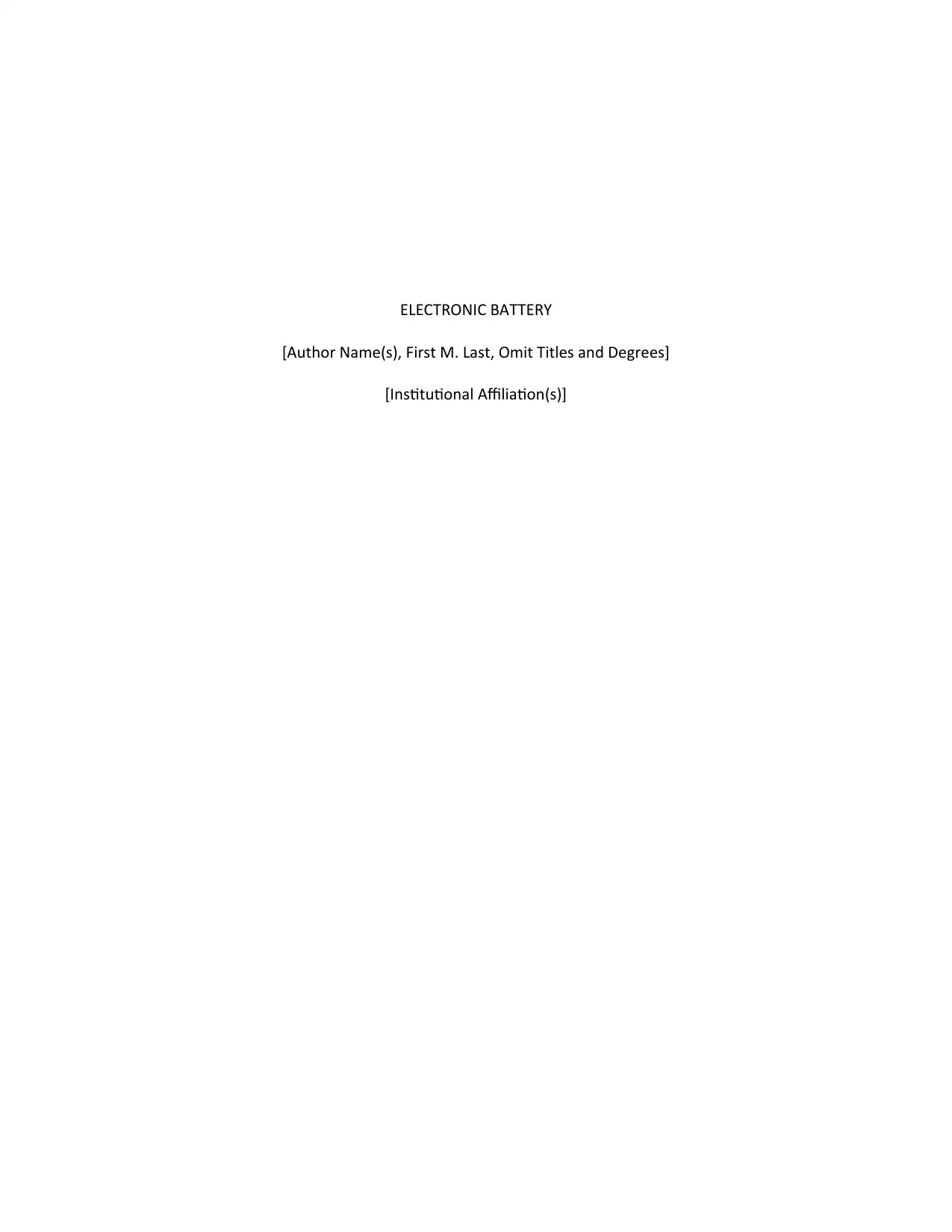
ELECTRONIC BATTERY
[Author Name(s), First M. Last, Omit Titles and Degrees]
[Institutional Affiliation(s)]
[Author Name(s), First M. Last, Omit Titles and Degrees]
[Institutional Affiliation(s)]
Paraphrase This Document
Need a fresh take? Get an instant paraphrase of this document with our AI Paraphraser
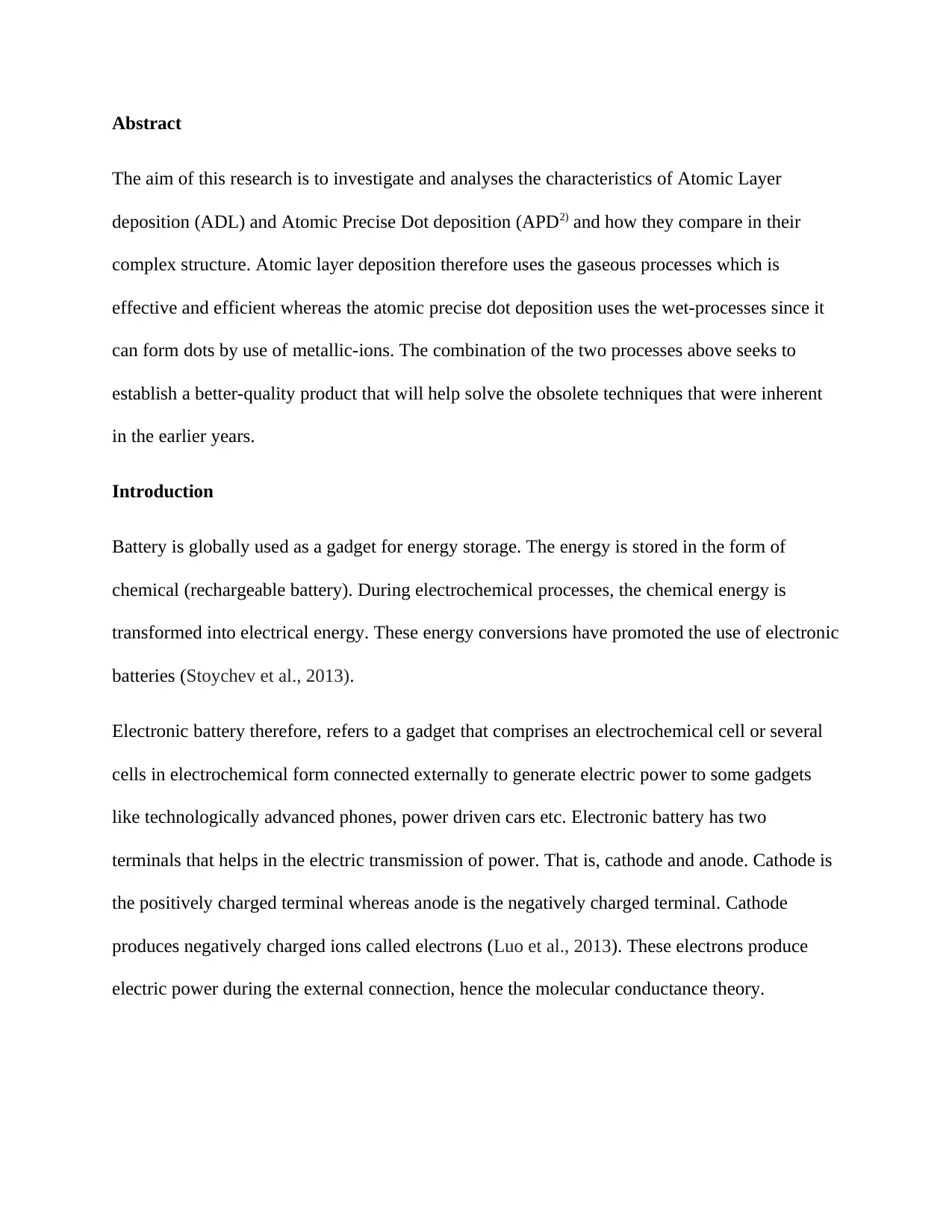
Abstract
The aim of this research is to investigate and analyses the characteristics of Atomic Layer
deposition (ADL) and Atomic Precise Dot deposition (APD2) and how they compare in their
complex structure. Atomic layer deposition therefore uses the gaseous processes which is
effective and efficient whereas the atomic precise dot deposition uses the wet-processes since it
can form dots by use of metallic-ions. The combination of the two processes above seeks to
establish a better-quality product that will help solve the obsolete techniques that were inherent
in the earlier years.
Introduction
Battery is globally used as a gadget for energy storage. The energy is stored in the form of
chemical (rechargeable battery). During electrochemical processes, the chemical energy is
transformed into electrical energy. These energy conversions have promoted the use of electronic
batteries (Stoychev et al., 2013).
Electronic battery therefore, refers to a gadget that comprises an electrochemical cell or several
cells in electrochemical form connected externally to generate electric power to some gadgets
like technologically advanced phones, power driven cars etc. Electronic battery has two
terminals that helps in the electric transmission of power. That is, cathode and anode. Cathode is
the positively charged terminal whereas anode is the negatively charged terminal. Cathode
produces negatively charged ions called electrons (Luo et al., 2013). These electrons produce
electric power during the external connection, hence the molecular conductance theory.
The aim of this research is to investigate and analyses the characteristics of Atomic Layer
deposition (ADL) and Atomic Precise Dot deposition (APD2) and how they compare in their
complex structure. Atomic layer deposition therefore uses the gaseous processes which is
effective and efficient whereas the atomic precise dot deposition uses the wet-processes since it
can form dots by use of metallic-ions. The combination of the two processes above seeks to
establish a better-quality product that will help solve the obsolete techniques that were inherent
in the earlier years.
Introduction
Battery is globally used as a gadget for energy storage. The energy is stored in the form of
chemical (rechargeable battery). During electrochemical processes, the chemical energy is
transformed into electrical energy. These energy conversions have promoted the use of electronic
batteries (Stoychev et al., 2013).
Electronic battery therefore, refers to a gadget that comprises an electrochemical cell or several
cells in electrochemical form connected externally to generate electric power to some gadgets
like technologically advanced phones, power driven cars etc. Electronic battery has two
terminals that helps in the electric transmission of power. That is, cathode and anode. Cathode is
the positively charged terminal whereas anode is the negatively charged terminal. Cathode
produces negatively charged ions called electrons (Luo et al., 2013). These electrons produce
electric power during the external connection, hence the molecular conductance theory.
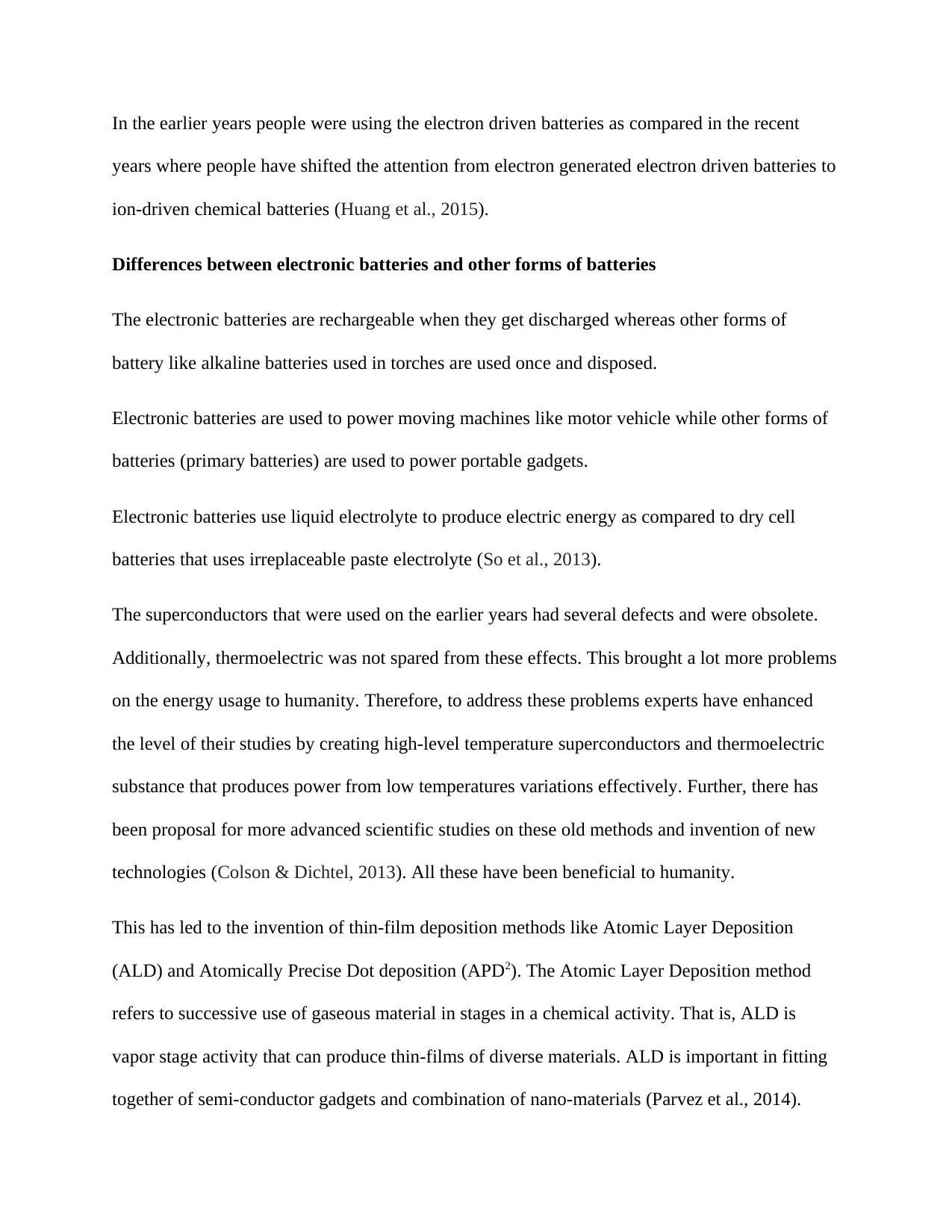
In the earlier years people were using the electron driven batteries as compared in the recent
years where people have shifted the attention from electron generated electron driven batteries to
ion-driven chemical batteries (Huang et al., 2015).
Differences between electronic batteries and other forms of batteries
The electronic batteries are rechargeable when they get discharged whereas other forms of
battery like alkaline batteries used in torches are used once and disposed.
Electronic batteries are used to power moving machines like motor vehicle while other forms of
batteries (primary batteries) are used to power portable gadgets.
Electronic batteries use liquid electrolyte to produce electric energy as compared to dry cell
batteries that uses irreplaceable paste electrolyte (So et al., 2013).
The superconductors that were used on the earlier years had several defects and were obsolete.
Additionally, thermoelectric was not spared from these effects. This brought a lot more problems
on the energy usage to humanity. Therefore, to address these problems experts have enhanced
the level of their studies by creating high-level temperature superconductors and thermoelectric
substance that produces power from low temperatures variations effectively. Further, there has
been proposal for more advanced scientific studies on these old methods and invention of new
technologies (Colson & Dichtel, 2013). All these have been beneficial to humanity.
This has led to the invention of thin-film deposition methods like Atomic Layer Deposition
(ALD) and Atomically Precise Dot deposition (APD2). The Atomic Layer Deposition method
refers to successive use of gaseous material in stages in a chemical activity. That is, ALD is
vapor stage activity that can produce thin-films of diverse materials. ALD is important in fitting
together of semi-conductor gadgets and combination of nano-materials (Parvez et al., 2014).
years where people have shifted the attention from electron generated electron driven batteries to
ion-driven chemical batteries (Huang et al., 2015).
Differences between electronic batteries and other forms of batteries
The electronic batteries are rechargeable when they get discharged whereas other forms of
battery like alkaline batteries used in torches are used once and disposed.
Electronic batteries are used to power moving machines like motor vehicle while other forms of
batteries (primary batteries) are used to power portable gadgets.
Electronic batteries use liquid electrolyte to produce electric energy as compared to dry cell
batteries that uses irreplaceable paste electrolyte (So et al., 2013).
The superconductors that were used on the earlier years had several defects and were obsolete.
Additionally, thermoelectric was not spared from these effects. This brought a lot more problems
on the energy usage to humanity. Therefore, to address these problems experts have enhanced
the level of their studies by creating high-level temperature superconductors and thermoelectric
substance that produces power from low temperatures variations effectively. Further, there has
been proposal for more advanced scientific studies on these old methods and invention of new
technologies (Colson & Dichtel, 2013). All these have been beneficial to humanity.
This has led to the invention of thin-film deposition methods like Atomic Layer Deposition
(ALD) and Atomically Precise Dot deposition (APD2). The Atomic Layer Deposition method
refers to successive use of gaseous material in stages in a chemical activity. That is, ALD is
vapor stage activity that can produce thin-films of diverse materials. ALD is important in fitting
together of semi-conductor gadgets and combination of nano-materials (Parvez et al., 2014).
⊘ This is a preview!⊘
Do you want full access?
Subscribe today to unlock all pages.

Trusted by 1+ million students worldwide

On the other hand, Atomic Precise Dot deposition (APD2) is defined as a wet- process due to
increased molecular force of dot-precursors identifying the number of metal-ions forming the
dots. This has facilitated the usage of biological processes like photosynthesis in which the
useful molecular moiety is organized through atomic-precision in 3-dimentions. This makes the
moiety to meet and freely execute useful operations from atomic-properties (Xia et al., 2013).
Characteristics of Atomic Layer Deposition (ALD)
It is based on the growth of Titanium dioxide thin-films through the process of Atomic
Layer Deposition. This Titanium Oxide (TiO2) is used as a photocatalyst and an
electrode (Mayabadi et al., 2014). It has high surface area that increases it performance.
Its smaller size increases band-conductivity and reduces the valence-band (Mardilovich,
Hoffman & Herman, 2013).
It is a vapor-based system
ALD is always faster and efficient than (APD2).
It takes shorter deposition time and better-quality film
Its chemically expandable to atomic precise dot deposition
ALD is applicable for fabricated-microelectronics because it can generate correct
thickness and identical materials.
Characteristics of Atomic Precise Dot deposition (APD2)
It is a wet-based process since it is unsuitable to vaporize heavy molecular dot-precursors
comprising of several metal-ions.
It is slow and inefficient as compared to ALD
Its dot-precursors are regulated on substrate to form mono-layer or few molecular-layers.
increased molecular force of dot-precursors identifying the number of metal-ions forming the
dots. This has facilitated the usage of biological processes like photosynthesis in which the
useful molecular moiety is organized through atomic-precision in 3-dimentions. This makes the
moiety to meet and freely execute useful operations from atomic-properties (Xia et al., 2013).
Characteristics of Atomic Layer Deposition (ALD)
It is based on the growth of Titanium dioxide thin-films through the process of Atomic
Layer Deposition. This Titanium Oxide (TiO2) is used as a photocatalyst and an
electrode (Mayabadi et al., 2014). It has high surface area that increases it performance.
Its smaller size increases band-conductivity and reduces the valence-band (Mardilovich,
Hoffman & Herman, 2013).
It is a vapor-based system
ALD is always faster and efficient than (APD2).
It takes shorter deposition time and better-quality film
Its chemically expandable to atomic precise dot deposition
ALD is applicable for fabricated-microelectronics because it can generate correct
thickness and identical materials.
Characteristics of Atomic Precise Dot deposition (APD2)
It is a wet-based process since it is unsuitable to vaporize heavy molecular dot-precursors
comprising of several metal-ions.
It is slow and inefficient as compared to ALD
Its dot-precursors are regulated on substrate to form mono-layer or few molecular-layers.
Paraphrase This Document
Need a fresh take? Get an instant paraphrase of this document with our AI Paraphraser
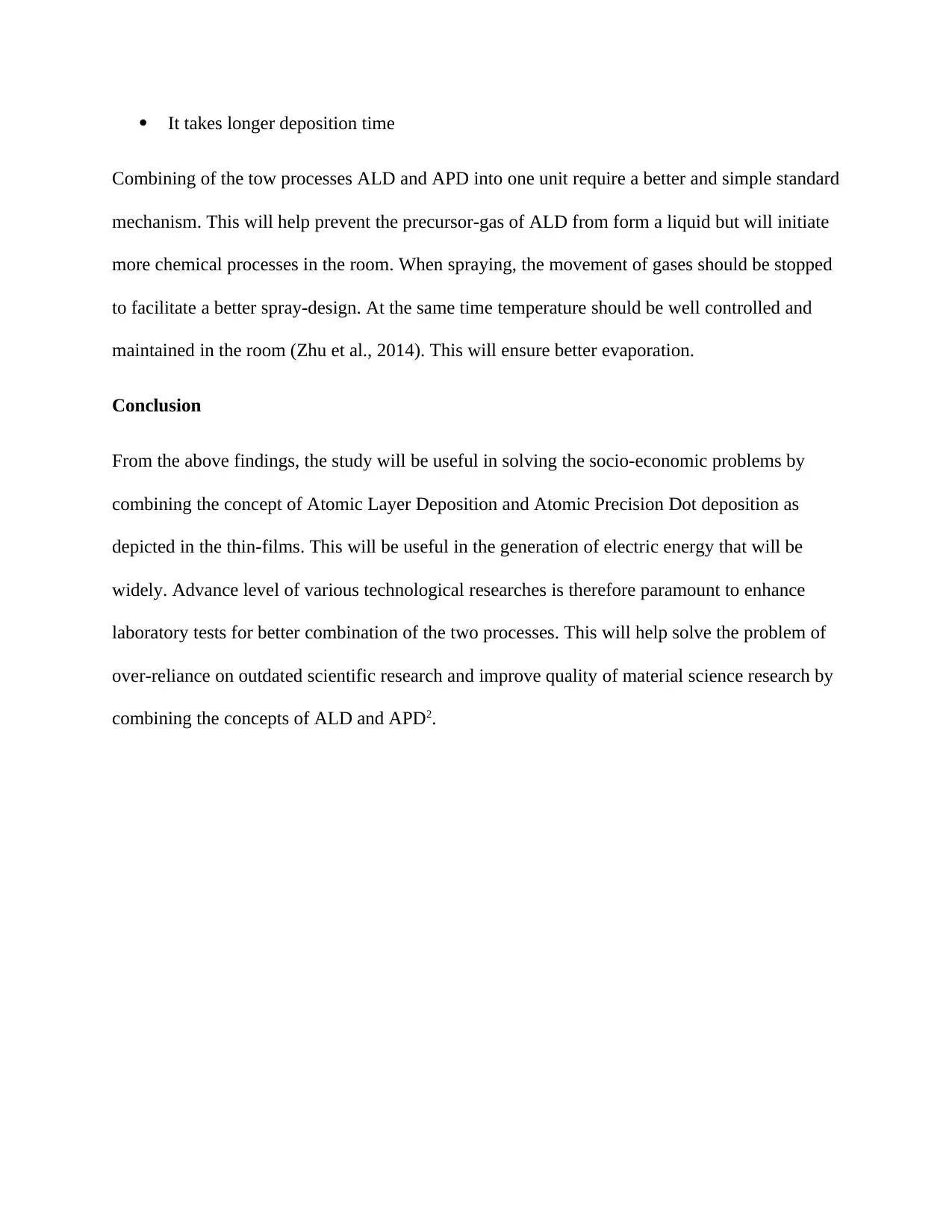
It takes longer deposition time
Combining of the tow processes ALD and APD into one unit require a better and simple standard
mechanism. This will help prevent the precursor-gas of ALD from form a liquid but will initiate
more chemical processes in the room. When spraying, the movement of gases should be stopped
to facilitate a better spray-design. At the same time temperature should be well controlled and
maintained in the room (Zhu et al., 2014). This will ensure better evaporation.
Conclusion
From the above findings, the study will be useful in solving the socio-economic problems by
combining the concept of Atomic Layer Deposition and Atomic Precision Dot deposition as
depicted in the thin-films. This will be useful in the generation of electric energy that will be
widely. Advance level of various technological researches is therefore paramount to enhance
laboratory tests for better combination of the two processes. This will help solve the problem of
over-reliance on outdated scientific research and improve quality of material science research by
combining the concepts of ALD and APD2.
Combining of the tow processes ALD and APD into one unit require a better and simple standard
mechanism. This will help prevent the precursor-gas of ALD from form a liquid but will initiate
more chemical processes in the room. When spraying, the movement of gases should be stopped
to facilitate a better spray-design. At the same time temperature should be well controlled and
maintained in the room (Zhu et al., 2014). This will ensure better evaporation.
Conclusion
From the above findings, the study will be useful in solving the socio-economic problems by
combining the concept of Atomic Layer Deposition and Atomic Precision Dot deposition as
depicted in the thin-films. This will be useful in the generation of electric energy that will be
widely. Advance level of various technological researches is therefore paramount to enhance
laboratory tests for better combination of the two processes. This will help solve the problem of
over-reliance on outdated scientific research and improve quality of material science research by
combining the concepts of ALD and APD2.
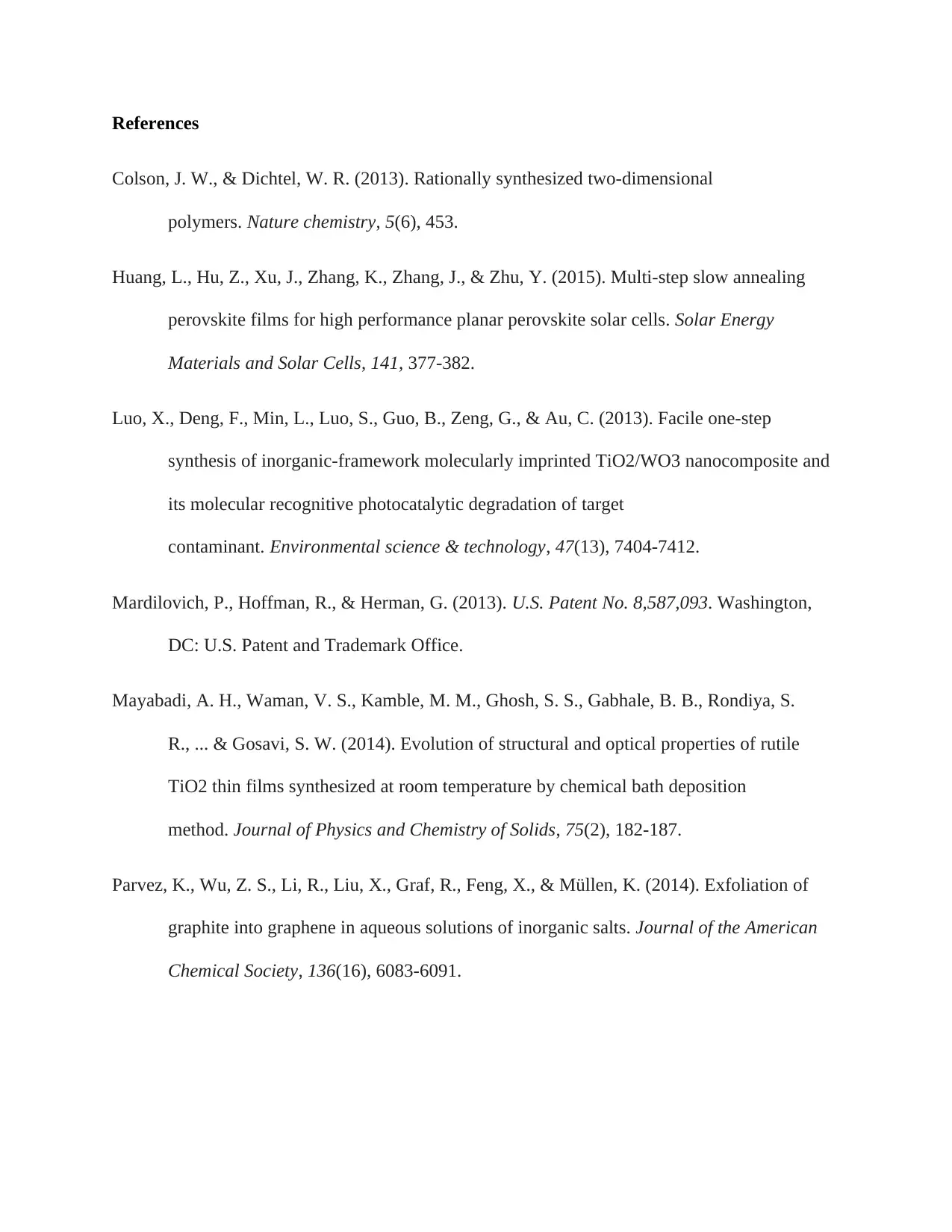
References
Colson, J. W., & Dichtel, W. R. (2013). Rationally synthesized two-dimensional
polymers. Nature chemistry, 5(6), 453.
Huang, L., Hu, Z., Xu, J., Zhang, K., Zhang, J., & Zhu, Y. (2015). Multi-step slow annealing
perovskite films for high performance planar perovskite solar cells. Solar Energy
Materials and Solar Cells, 141, 377-382.
Luo, X., Deng, F., Min, L., Luo, S., Guo, B., Zeng, G., & Au, C. (2013). Facile one-step
synthesis of inorganic-framework molecularly imprinted TiO2/WO3 nanocomposite and
its molecular recognitive photocatalytic degradation of target
contaminant. Environmental science & technology, 47(13), 7404-7412.
Mardilovich, P., Hoffman, R., & Herman, G. (2013). U.S. Patent No. 8,587,093. Washington,
DC: U.S. Patent and Trademark Office.
Mayabadi, A. H., Waman, V. S., Kamble, M. M., Ghosh, S. S., Gabhale, B. B., Rondiya, S.
R., ... & Gosavi, S. W. (2014). Evolution of structural and optical properties of rutile
TiO2 thin films synthesized at room temperature by chemical bath deposition
method. Journal of Physics and Chemistry of Solids, 75(2), 182-187.
Parvez, K., Wu, Z. S., Li, R., Liu, X., Graf, R., Feng, X., & Müllen, K. (2014). Exfoliation of
graphite into graphene in aqueous solutions of inorganic salts. Journal of the American
Chemical Society, 136(16), 6083-6091.
Colson, J. W., & Dichtel, W. R. (2013). Rationally synthesized two-dimensional
polymers. Nature chemistry, 5(6), 453.
Huang, L., Hu, Z., Xu, J., Zhang, K., Zhang, J., & Zhu, Y. (2015). Multi-step slow annealing
perovskite films for high performance planar perovskite solar cells. Solar Energy
Materials and Solar Cells, 141, 377-382.
Luo, X., Deng, F., Min, L., Luo, S., Guo, B., Zeng, G., & Au, C. (2013). Facile one-step
synthesis of inorganic-framework molecularly imprinted TiO2/WO3 nanocomposite and
its molecular recognitive photocatalytic degradation of target
contaminant. Environmental science & technology, 47(13), 7404-7412.
Mardilovich, P., Hoffman, R., & Herman, G. (2013). U.S. Patent No. 8,587,093. Washington,
DC: U.S. Patent and Trademark Office.
Mayabadi, A. H., Waman, V. S., Kamble, M. M., Ghosh, S. S., Gabhale, B. B., Rondiya, S.
R., ... & Gosavi, S. W. (2014). Evolution of structural and optical properties of rutile
TiO2 thin films synthesized at room temperature by chemical bath deposition
method. Journal of Physics and Chemistry of Solids, 75(2), 182-187.
Parvez, K., Wu, Z. S., Li, R., Liu, X., Graf, R., Feng, X., & Müllen, K. (2014). Exfoliation of
graphite into graphene in aqueous solutions of inorganic salts. Journal of the American
Chemical Society, 136(16), 6083-6091.
⊘ This is a preview!⊘
Do you want full access?
Subscribe today to unlock all pages.

Trusted by 1+ million students worldwide
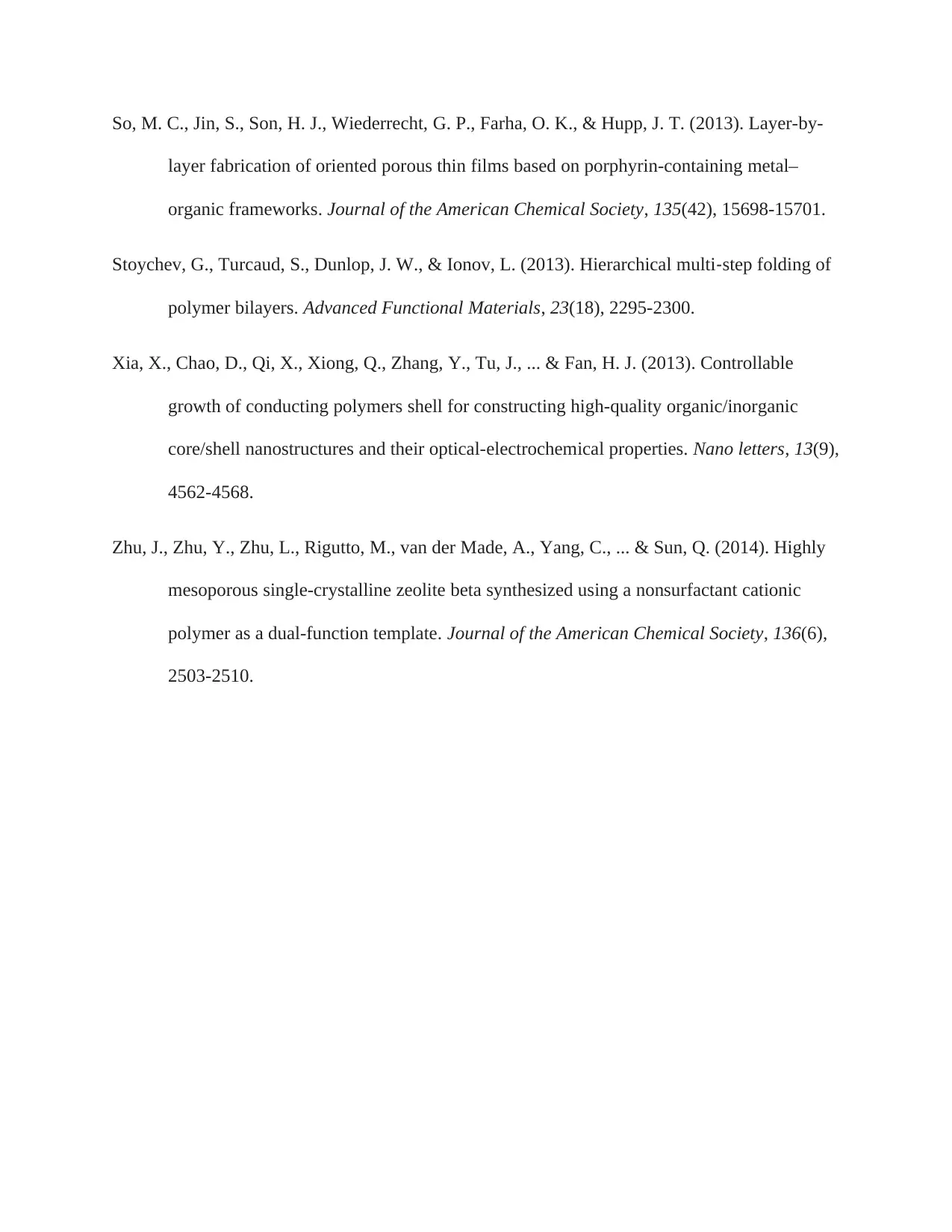
So, M. C., Jin, S., Son, H. J., Wiederrecht, G. P., Farha, O. K., & Hupp, J. T. (2013). Layer-by-
layer fabrication of oriented porous thin films based on porphyrin-containing metal–
organic frameworks. Journal of the American Chemical Society, 135(42), 15698-15701.
Stoychev, G., Turcaud, S., Dunlop, J. W., & Ionov, L. (2013). Hierarchical multi‐step folding of
polymer bilayers. Advanced Functional Materials, 23(18), 2295-2300.
Xia, X., Chao, D., Qi, X., Xiong, Q., Zhang, Y., Tu, J., ... & Fan, H. J. (2013). Controllable
growth of conducting polymers shell for constructing high-quality organic/inorganic
core/shell nanostructures and their optical-electrochemical properties. Nano letters, 13(9),
4562-4568.
Zhu, J., Zhu, Y., Zhu, L., Rigutto, M., van der Made, A., Yang, C., ... & Sun, Q. (2014). Highly
mesoporous single-crystalline zeolite beta synthesized using a nonsurfactant cationic
polymer as a dual-function template. Journal of the American Chemical Society, 136(6),
2503-2510.
layer fabrication of oriented porous thin films based on porphyrin-containing metal–
organic frameworks. Journal of the American Chemical Society, 135(42), 15698-15701.
Stoychev, G., Turcaud, S., Dunlop, J. W., & Ionov, L. (2013). Hierarchical multi‐step folding of
polymer bilayers. Advanced Functional Materials, 23(18), 2295-2300.
Xia, X., Chao, D., Qi, X., Xiong, Q., Zhang, Y., Tu, J., ... & Fan, H. J. (2013). Controllable
growth of conducting polymers shell for constructing high-quality organic/inorganic
core/shell nanostructures and their optical-electrochemical properties. Nano letters, 13(9),
4562-4568.
Zhu, J., Zhu, Y., Zhu, L., Rigutto, M., van der Made, A., Yang, C., ... & Sun, Q. (2014). Highly
mesoporous single-crystalline zeolite beta synthesized using a nonsurfactant cationic
polymer as a dual-function template. Journal of the American Chemical Society, 136(6),
2503-2510.
1 out of 7
Related Documents
Your All-in-One AI-Powered Toolkit for Academic Success.
+13062052269
info@desklib.com
Available 24*7 on WhatsApp / Email
![[object Object]](/_next/static/media/star-bottom.7253800d.svg)
Unlock your academic potential
Copyright © 2020–2025 A2Z Services. All Rights Reserved. Developed and managed by ZUCOL.



